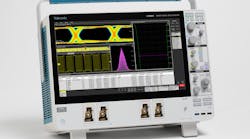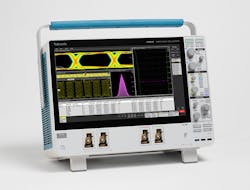Last year, Tektronix made headlines by introducing the 5 Series MSO product line. These mixed-signal oscilloscopes (MSOs) offer bandwidths as high as 2 GHz along with a 12-b vertical resolution and real-time sampling rates as high as 6.25 Gsamples/s. Not stopping there, Tektronix raised the MSO bar higher with the recent introduction of its 6 Series MSO oscilloscopes (see figure).
While the 5 Series MSO oscilloscopes offer bandwidths as high as 2 GHz, the 6 Series MSO instruments take it further by reaching bandwidths topping out at 8 GHz. Customers have five different bandwidth options to choose from when selecting a 6 Series model: 1, 2.5, 4, 6, and 8 GHz. Furthermore, the 6 Series MSO oscilloscopes achieve 25-Gsample/s sample rates on all channels simultaneously.
Like the 5 Series, the 6 Series MSO instruments feature a 12-bit analog-to-digital converter (ADC). High-res mode extends the number of bits to 16. A digital-signal-processing (DSP) filter is the driving force behind high-res mode—it limits bandwidth, and thus noise, to provide a more accurate view of a signal.
The 6 Series MSO oscilloscopes offer bandwidths as high as 8 GHz along with 25-Gsample/s sample rates.
A significant trait of the 6 Series MSO oscilloscopes is the new TEK061 front-end application-specific integrated circuit (ASIC). According to Tektronix, it enables “breakthrough” noise performance at the highest sensitivity settings. In fact, the company states that the 6 Series oscilloscopes provide greater than 75% reduction in noise at 1 mV/div in comparison to a typical oscilloscope. With a 1-GHz bandwidth, RMS noise is 54.8 µV at 1 mV/div.
Another point to take note of is visual triggering, which is a new feature that uses graphical areas to define triggers to enable users to save time hunting for the signal of interest. With visual triggering, the oscilloscope scans through all waveform acquisitions and compares them to geometric shapes, such as triangles, rectangles, hexagons, or trapezoids. Users can also build their own custom shapes.
The 6 Series MSO oscilloscopes also feature FlexChannel technology, which enables each of the four inputs on an instrument to be used as a single analog channel or as eight digital channels. Accessing the eight digital channels requires using a TLP058 probe. Users can connect as many TLP058 probes to an instrument as needed, allowing for as many as 32 digital channels.
Speaking of probes, Tektronix also launched some new versions that tie into the 6 Series MSO oscilloscopes. The TDP7700 TriMode probes are available with bandwidths of 4, 6, or 8 GHz. With TriMode functionality, one probe setup can accurately make differential, single-ended, and common-mode measurements. Tektronix also launched the TDP4000 and TAP4000 4-GHz bandwidth probes. The TDP4000 probes are differential, while the TAP4000 probes are single-ended versions.
Like the 5 Series MSO instruments, the 6 Series MSO oscilloscopes display results on a 15.6-in capacitive touchscreen. The scopes weigh about 28 pounds.


